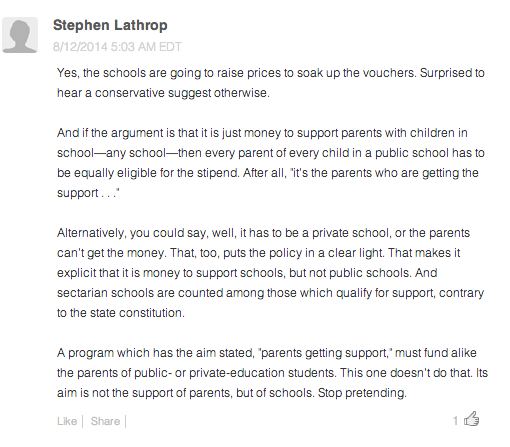Friday Freakout: Vouchers Aim to Support Private Schools, Not Students?
Today’s freakout comes to us from the comments section of the The Washington Post piece “Amicus brief on empirical data about school vouchers”. The article itself explains Douglas County, Colorado’s school voucher pilot program, which allows up to 500 students (out of 66,000 in the district) to receive an education voucher.
The ACLU of Colorado sued to stop the voucher program, won in state district court, and lost in the Colorado Court of Appeals. Now, the Colorado Supreme Court will hear the case.
Also discussed in the article were responses to the claims made in amicus briefs filed by opponents of school choice programs, including the National Education Association and the American Federation of Teachers. Ultimately, the comments section was full of spirited discussion of how people personally would determine the program’s constitutionality. This post caught our attention:

First, it’s important to know that the Douglas County School Board created the pilot voucher program. The board members, who were elected by voters in their district to represent the needs of the community, were confident in the quality of their public schools for most kids, but recognized some students are bound to learn better in a different educational setting.
One of Mr. Lathrop’s main concerns was whether every student, no matter what school they choose to attend, is eligible to use a voucher. The Douglas County voucher program is actually one of the most equitable in the country as far as eligibility goes. For the program law’s jurisdiction, which is only Douglas County, every student who attends a public school is eligible for a voucher. Students who are already enrolled in private school are not eligible.
Public school students cannot get voucher funds to use for their education if they remain in a public school, however. If that were to happen, those students would be double-funded – once in public school per-pupil funding and once in the form of voucher dollars – while the students who used their vouchers to attend an independent school would be half as funded as students in public schools. So to clarify, vouchers are not extra money people get to use on top of what the state funds district schools. They are a device for distributing existing education funds differently.
To understand the way the program works now, imagine every public school student in the district gets a “voucher.” The kids who stay enrolled in their public school? Their vouchers go to their public school of choice. The kids who switch to an independent school? Their vouchers, which are worth less money than kids who stay in public school, go to their independent school of choice. If a dollar amount is a measure of how much education one receives, the Douglas County voucher program actually does not incentivize people to attend private schools.
This concept brings us to Mr. Lathrop’s next concern – that the program’s main purpose is to give private schools money and create a cycle of tuition inflation at the expense of taxpayers.
To say, “No, the purpose of the program is to help kids who are struggling in their zoned public school to get the best education for their needs,” isn’t enough to dispute Mr. Lathrop’s claim. So let’s follow his logic to see what would really be likely to happen.
If private schools were to raise tuition rates in direct response to vouchers, they run the huge risk of losing the families who already pay out of pocket. Worse even, if they raise rates too far above the value of a voucher, the families who need the financial assistance of a voucher won’t be able to afford to make up the difference to attend their schools anyway. So where will those students go? They’ll be forced to attend the cheaper option, which will almost certainly be their tuition-free public school. Then, all parties are back at square one…only private schools would be worse off because they would have lost potential voucher student enrollment and some of their existing non-voucher students.
Again, even if the Douglas County voucher program were private school-centric (which it’s not), inflating tuition rates simply would not be in the best interest of private schools. That is probably why, in our experience, we’ve seen most private school leaders accept the voucher amount as a student’s tuition fee, offer additional financial aid, or work with parents to set a feasible payment plan for any leftover fees.
In the end, school voucher programs, especially one led by the public school district itself, are hardly anti-public school. Neither is the district attempting to isolate itself from students from neighboring towns by implementing an optional voucher program. Douglas County actually allows open enrollment among their public schools, so students from outside their district can attend their schools. But ultimately, the Douglas County School Board only has jurisdiction over the students who live in Douglas County. If the answer to making the voucher program more inclusive were creating a statewide voucher program that is open for students from all districts to use their voucher flexibly at any type of school or educational service – public, charter, private, virtual, blended, home, or otherwise – we’d be thrilled!
And if you think that’s a more fair way of doing things, then you might have just realized you are, in fact, a school choice supporter.




